| SLRS AND SLR-LIKE CAMERAS |
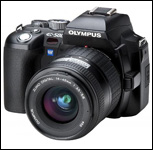 Olympus E-500, 8MP ($799.99 with the 14-45mm lens; $899.99 with the additional 40-150mm lens) Olympus E-500, 8MP ($799.99 with the 14-45mm lens; $899.99 with the additional 40-150mm lens)
When I think Single Lens Reflex (SLR), I usually think Canon or Nikon, but this Olympus number takes really sharp, high-quality photos in all types of lighting. The downside is the menu: even though it’s easy to use, the controls can be viewed only through the back LCD, forcing you to remove your eye from the viewfinder to adjust the settings. |
Fuji S9000, 9MP, 10.7x Optical Zoom ($699.99 before the $100 rebate, good until June 30, 2006)
Unlike most SLRs, the Fuji takes regular AA batteries, which it ate through at a rapid pace. But it makes up for the battery problem by providing two slots for two different kinds of memory cards. Other perks include a pop-out adjustable LCD screen — which reduces glare and helps you take pictures from odd angles. You can also zoom in and out and keep a clear image while videotaping. |
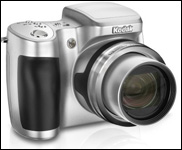 Kodak Z650, 6.1MP, 10x Optical Zoom ($349.95) Kodak Z650, 6.1MP, 10x Optical Zoom ($349.95)
This lightweight “SLR-like” camera is not much bigger than some regular point-and-shoots, but it has a 10x zoom (compared with the average 3x zoom), giving a much greater wide angle to telephoto. The controls are easy to work: just use the small joystick to move around the menu, and push it in when you want to change a setting. Still pics came out clear and sharp, but video did not do a very good job adjusting its focus as I moved the camera around. |
| POINT-AND-SHOOTS |
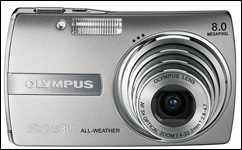 Olympus Stylus 810, 8MP, 3x Optical Zoom ($429.99) Olympus Stylus 810, 8MP, 3x Optical Zoom ($429.99)
Given this camera’s shake warning and on-screen histogram while you shoot, it seems almost impossible to ruin a photo. The camera is compact and takes crystal-clear photos and videos. Video stayed clear and focused as I panned the camera, and the audio also came out loud and clear, despite a slight buzzing sound. |
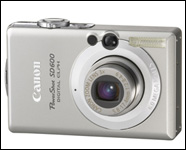 Canon SD600 Elph, 6MP, 3x Optical Zoom ($300–$350) Canon SD600 Elph, 6MP, 3x Optical Zoom ($300–$350)
This is the perfect take-anywhere camera, but be forewarned: although it took nice daytime photos, I found the flash photos to be a bit grainy. The one thing I have to mention — because it’s just too funny not to — is that Canon has gone to the trouble of giving the photographer a choice of camera sounds. So, besides the normal bells and whistles, your camera can ring like a telephone, chirp like a bird, or bark like a dog. |
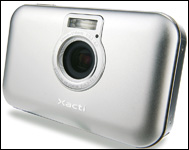 Sanyo E6, 6MP, 3x Optical Zoom ($250–$315) Sanyo E6, 6MP, 3x Optical Zoom ($250–$315)
When you first turn on this camera, it gives you an audio step-by-step play of what you’re doing, as you do it. It immediately annoyed me, so Sanyo E6 and I got off on the wrong foot. I turned off that function and went about my business, then warmed up to the clean videos with high-quality sound. (Plus, its ability to take stills from the videos seemed very CSI.) On the negative side, the ultra-sensitive shutter (one of the big selling points of the camera) didn’t make focusing easier than any other point-and-shoot. In fact, I think it hindered the focusing process. |
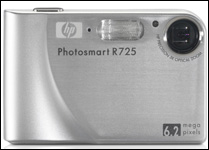 HP R725, 6.2MP, 3x Optical Zoom ($249.99) HP R725, 6.2MP, 3x Optical Zoom ($249.99)
It’s cute and compact and takes quality photos, day or night. But with this camera there’s a lack of control that makes for a frustrating experience for the trained photographer. You can either choose one of the scenes provided or pick “auto scene.” I could fudge with the ISO, white balance, and saturation a little, but the setting always won out. While the kid in front of me at the Mustard Plug/Big D and the Kids Table show at Avalon took what looked like good pictures, I got blurry masses moving around the stage. |
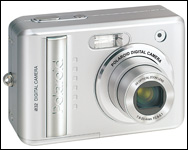 Polaroid i832, 3x Optical Zoom ($219–$250) Polaroid i832, 3x Optical Zoom ($219–$250)
My favorite thing about this camera is that it comes with a little leather case. This may not seem like much, but I had the hardest time finding one for my personal point-and-shoot. Otherwise, the photo quality is decent, but due to the lack of shake warning, I found several of the photos blurry and out of focus for one reason or another. |